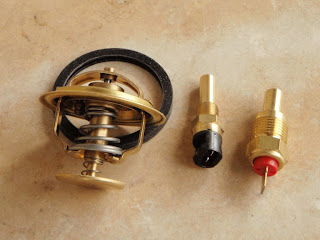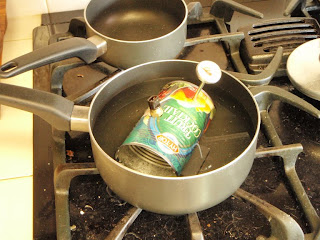Well ... it's another weekend, and I'm back to troubleshooting my "warm engine poor idle followed by stalling" problem. Suspecting a bad coolant temperature sensor for the D-Jet EFI system, and not knowing the exact range of resistance values for a good sensor across a wider range of temperatures beyond the 50F - 104F outlined in the 1800E Service Manual (the "Green Book"), I had no other option but to order a new part. Besides, installing a new coolant temp sensor or removing the old one for testing would require draining coolant from the engine anyway, and because having new parts is waaaayyy better than money in the bank, I decided to replace the thermostat and the sender for the coolant temperature gauge as well.
Armed with a new and old coolant temp sensor, I took the opportunity to do some bench testing in the kitchen to satisfy my own curiosity. Drilling 2 holes in an empty food can, one for the sensor, and one for the food thermometer (classy ... I know!), I was able to submerge the contraption into a pot of water and take resistance readings with my multi-meter while slowly bringing the water to a boil. Results are as follows:
| Temp | New Sensor | Old Sensor |
| 80F | 2000 ohms | 2500 ohms |
| 90F | 1400 ohms | 1800 ohms |
| 100F | 1000 ohms | 1400 ohms |
| 110F | 1000 ohms | 1200 ohms |
| 120F | 800 ohms | 1000 ohms |
| 130F | 800 ohms | 800 ohms |
| 140F | 600 ohms | 600 ohms |
| 150F | 400 ohms | 500 ohms |
| 160F | 350 ohms | 450 ohms |
| 170F | 350 ohms | 400 ohms |
| 180F | 260 ohms | 350 ohms |
| 190F | 260 ohms | 300 ohms |
| 200F | 250 ohms | 250 ohms |
New Thermostat & Engine Sensors:

| Testing the Coolant Temp Sensor:

|
I began taking readings at room temperature water (80F according to the food thermometer) ... obviously a well calibrated instrument! You can count on those numbers ... trust me, I'm a lawyer! Anyway, although, the new and old sensors have different resistance values at the same temperatures, the one shared trait is that the resistance values do drop at increased temperatures. Not entirely sure if they need to hit an exact resistance value "on the money" at a given temperature or just be "within range", there's no way from looking at the table above for me to tell if the old sensor was really "bad" as I originally suspected. I say "originally", because installing the new thermostat and coolant temp sensor did absolutely nothing to change the running conditions of the engine - hence the old sensor should still be good ... unless it's the wiring from the sensor to the Electronic Control Unit (ECU) that's crap - I'll have to check that at a later time.
Acknowledgements:- Parts were purchased from iRoll Motors.
- Funds for this failed attempt at engine diagnostics provided by Union Bank of California.
- Food can provided by Hi-Top Fruit Cocktail
- Food thermometer made in China.
- Multi-meter also made in China.
- This site was tested on animals. They didn't get it either.


No comments:
Post a Comment